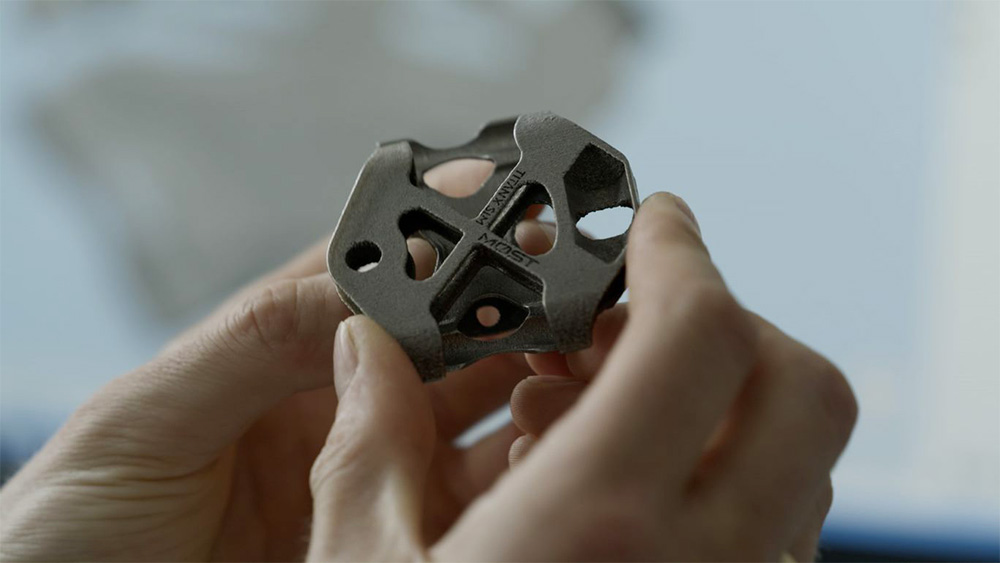Executive Editor Joris Peels recently did a deep dive into the existing and possible role of 3D printing in the cycling industry. A disruption could be imminent, if industry players recognize the opportunity and leverage it in the appropriate way. One such entry point is through the use of 3D printing for high-end bikes, such as specialty consumer bicycles and racing bikes.
Italian manufacturer Pinarello is now using Materialise (Nasdaq: MTLS) technology to optimize and manufacture a seat component with metal 3D printing at scale. Working with Materialise’s Metal Competence Center, the company was able to cut the weight of seat clamps for its new Dogma F racing bike by 42.5 percent.
“The design and engineering were done in close collaboration with Pinarello,” said Tim Hermanski, Design Engineer at Materialise. “With each design iteration, we first completed virtual simulation tests. The seat clamp needed to be lightweight, but its purpose requires enough strength to hold the weight of the cyclist. These internal tests saved a lot of time ensuring printability and reliability of the final part.” Virtual tests were followed by physical trials, such as fatigue testing on a test bench and in the field, performed by the Pinarello team.
Using a custom workflow, the Materialise team was able to manufacture the necessary number of parts in a short period of time. Specifically, the bike maker needed to make some 2,000 parts in less than a month on a monthly basis. Materialise developed a custom production setup that included labeling and quality inspection to tackle the goal. This included the use of the Materialise Process Tuner, a soon-to-be-released product that tailors product development to a given application. In turn, parameter setup is sped up, while mistakes are reduced and key data are stored in a central databased for projects down the road.
“We had to introduce industrialization within our production chain,” says Philip. “We did so by designing a part and a process that needed no support structures or manual post-processing steps. Eliminating these steps saved us a lot of time during manufacturing. We also created a custom printing parameter set that sped up printing time, met the required material properties, and made the project feasible by optimizing costs,” said Philip Buchholz, Technical Project Manager at Materialise. Due to the use of the new Process Tuner software, Bucholz said that printing parameters were optimized “in a matter of weeks instead of months.”
The final titanium component was 3D printed using laser powder bed fusion. Not only was the piece lighter than its traditionally made aluminum counterpart, but Materialise was also able to manufacture 20,000 units more quickly than would have been possible with conventional processes.
Maurizio Bellin, Chief of Operations at Pinarello, explained that 3D printing has opened up the possibility of offering performance bikes to a larger number of people:
“Thanks to Materialise and our attention to detail, we saved 35 grams just on the small seat post clamp. To put that into perspective, that’s 8 more grams saved than the final weight reduction of the seat post itself. The details make the difference. And thanks to 3D printing, we can really prove that. But it’s not only about the weight savings. With 3D printing’s accessibility, we can offer this technology to more than just the top cyclists competing in the Tour de France. We can offer it to everyone around the world.”
Every little bit of weight savings can aid a racing cyclist, so naturally we’d see 3D printing come into play increasingly in this space. With a hefty $6,950 for the frameset alone, the Dogma F is geared toward high-end consumers, for whom cycling is more than just a hobby. However, by demonstrating the ability to manufacture 2,000 units on a monthly basis, Materialise is opening the door to an increasing number of lightweighted parts making it into more mainstream bikes in the future.
Subscribe to Our Email Newsletter
Stay up-to-date on all the latest news from the 3D printing industry and receive information and offers from third party vendors.
Print Services
Upload your 3D Models and get them printed quickly and efficiently.
You May Also Like
The Dental Additive Manufacturing Market Could Nearly Double by 2033, According to AM Research
According to an AM Research report from 2024, the medical device industry, specifically in dentistry, prosthetics, and audiology, is expected to see significant growth as these segments continue to benefit from...
Heating Up: 3D Systems’ Scott Green Discusses 3D Printing’s Potential in the Data Center Industry
The relentless rise of NVIDIA, the steadily increasing pledges of major private and public investments in national infrastructure projects around the world, and the general cultural obsession with AI have...
AM Research Webinar Explores Continuum’s Sustainable Metal Additive Manufacturing Powders
Metal additive manufacturing (AM) powder supplier Continuum Powders is working to develop solutions that empower industries to reduce waste and optimize their resources. An independent life cycle assessment (LCA) of...
3D Printed Footwear Startup Koobz Lands $7.2M in Seed Round
California-based Koobz is focused on reshoring the U.S. footwear supply chain with advanced manufacturing processes, including 3D printing. The startup just announced that it has added $6 million to its...


































